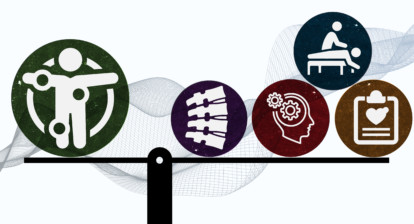Maybe you’re looking for a way to boost your body’s performance. And keep performing at that higher level. And you don’t mind pulling in technology to help you do that.
This is called biohacking. Defined by Bulletproof Nutrition Inc. founder Dave Asprey, biohacking centers around using science, biology and self-experimentation to take control of and optimize one’s body.
“People want to be able to do a lot of things,” Asprey said in a 2018 Forbes article, “whether it’s to look or feel a certain way, to run faster, to lift heavy things, to have enough energy to play with one’s kids after a full day of work, or be able to run a company and then be able to go to sleep at night.”
“Life is about making choices,” said Jeffrey Tucker, DC, DACRB, in an article published recently in The American Chiropractor. “Biohacking is using cutting-edge information, ancestral living, technology and assessments about yourself to make choices and consider the best approach to improve your overall health and well-being.”
In this article, we look at how the principles behind biohacking may or may not fit in with vitalistic chiropractic in particular.
Wait … biohacking in chiropractic?
There are parallels that can be drawn between biohacking principles and those of vitalistic chiropractic care, says Sean Drake, DC. Biohacking approaches provide ways for the body to perform at its optimal potential, and chiropractic adjustments that remove subluxations have the same general goal.
Dr. Drake founded the Life Chiropractic College West Sports Performance Institute in 2016 and now serves as Performance Director at the Titleist Performance Institute. He believes a merger of ideas from the fields of biohacking, body hacking and chiropractic could change the lives of those receiving chiropractic care and make it easier for everyone to operate at full capacity.
“There are four pillars that chiropractic can approach when looking at body hacking,” Dr. Drake said. “There’s an assessment for specific human movement, nutrition, equipment and technology, and mental well-being.”
Monitoring specific movements and nutrition, Dr. Drake said, allows for the body to prepare for certain stresses in athletics and leisure activities. Equipment and technology such as specialty socks or chiropractic tools target specific areas of concern, while assessments for mental well-being help patients understand how to use the body’s innate intelligence and promote wellness.
“The brain runs everything,” Dr. Drake said. “The mind is huge, and there is so much scientific data coming out right now on virtual reality, visualization, meditation and mental stimulation.”
Life West teaches that innate intelligence encourages every action in the body, always pushing the body toward healing and wellness. When vertebral subluxations exist, the nervous system can become compromised by the resulting interference, meaning the entire body operates at less than its full potential.
In the Vitalistic model that Life West builds its philosophy around, frequent adjustments ensure that subluxations are removed often, so that the nervous system can operate without interference and at its full potential. Biohacking practices also aim to push the body to perform at its full potential.
Dr. Drake said advancements in biohacking technology could revolutionize chiropractic care. He thinks chiropractors should embrace such tools and specialize in an aspect of care that will thrive when such technologies become more common.
“Brain mapping, body morphing, imaging and assessments will all become more advanced in time,” Dr. Drake said, adding that chiropractors could specialize in areas such as sports performance, brain performance and human performance.
Getting back to a vitalistic philosophy
Thoughts about biohacking vary widely, however, even within the Life West community. Life West Director of Alumni Relations Palmer Peet, DC, said some biohacking principles go against those of vitalistic chiropractic.
“Vitalistic chiropractors are of the belief that we are already perfect, and that we don’t need to be hacked, unhacked, stimulated or inhibited,” Dr. Peet said. “We just have to normalize function.”
Dr. Peet added that the removal of subluxations through adjustments is the core tenet of vitalistic chiropractic. He believes that is the primary responsibility of a practicing chiropractor, and external tweaks to the system seem unnecessary.
“A common saying we have is that nature doesn’t need any help, just no interference,” he said. “We are to remove interference from the nervous system. That’s what chiropractors do.”
Ankur Tayal, DC, the head of Life West’s philosophy department, believes that there might be a middle ground between using biohacking principles to guide health potential and avoiding all biohacking technology in favor of pure Vitalistic practices. His views stem from the relationships between universal, innate and educated intelligence, which he says are constantly evolving.
“Universal intelligence is that which transcends the world,” he explained. “Innate intelligence is found in a living being or vessel, and educated intelligence is a further subset, as some living beings have nervous systems and the capacity for rational thought.”
Educated intelligence has developed over time with advanced technology, as well as knowledge of both the world around us and social norms accepted by society. While Dr. Tayal acknowledged that certain biohacking concepts such as meditation take place with innate intelligence in mind, practitioners must be careful not to contradict the philosophies that vitalistic chiropractic is built on.
“We’re using our educated minds to separate ourselves from nature,” Dr. Tayal said. “The more we do that, the more we’re making a mistake. The more we use it to find wisdom that is contained innately and in nature, the more concepts like biohacking appeal to me.”
Drawing a line
Some definitions of biohacking and “body hacking” involve the use of technology implants and machinery. This can include implanting cameras into one’s head, for example, or the use of lights underneath the skin.
The existence of an ongoing conversation about biohacking and body hacking serves as a reminder that people will exercise many methods to boost and maintain performance. In chiropractic, finding the level at which one is comfortable with biohacking principles is informed by personal chiropractic philosophy as well as comfort with available technology.








